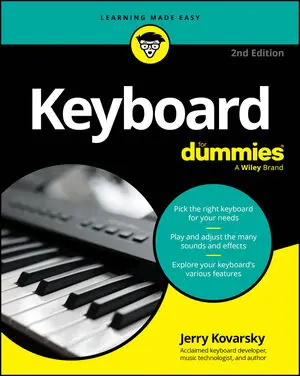Articles & Books From Instruments
Discover the keyboard that's right for you, whatever your budget! Looking for a fun, challenging, and rewarding new instrument to play? Thinking about the piano but don't necessarily have the room or the budget to put one in your home? Then grab a copy of the second edition of Keyboard For Dummies! In the book, acclaimed music technologist and keyboardist Jerry Kovarsky explores the wide variety of keyboards available, their sounds and features, and how to find the one that's right for you.
Cheat Sheet / Updated 08-18-2025
Playing keyboards takes you on a journey that goes far beyond just playing the music. You have to keep up on a lot of tech talk and sift through a wide variety of gear and manufacturers.Common keyboard terms and abbreviationsKeyboard manuals, web pages, and videos use all sorts of abbreviations and terms you may not be familiar with.
Step by Step / Updated 10-27-2023
To expand your piano expertise, you should try some broken chord exercises. Broken-chord patterns are common in accompaniment figures and can help make you a well-rounded player. Check out these four patterns found in a wide range of styles.Alberti bass exerciseThe Alberti bass is common in classical-style accompaniments.
Step by Step / Updated 10-27-2023
When the singer needs a good intro, who’s going to play it? The drummer? Probably not. You are. A piano or keyboard intro is a great addition to a song. And it can’t be any old intro — it’s gotta be good. The audience has a tendency to talk between songs, so it’s your job to shut ’em up and announce the start of the new song.
Step by Step / Updated 10-27-2023
You can use the pedal on the piano or keyboard to achieve different effects with your musical sound and add a whole new dimension to your playing. Give these exercises a try for some practice.Uniform Pedal Changes on One LineAlthough changing the pedal with the change of harmony is a general rule, change it more frequently when you’re also playing a melodic line.
Step by Step / Updated 10-27-2023
The key to making good, accurate jumps on the piano or keyboard is the same whether the jump is big or small: Maintain a comfortable, balanced hand position as you jump from the starting hand position across the keyboard to your landing destination. Jumping with an overextended pinky and your hand outstretched like the descent of a giant hawk upon its prey is very common.
Step by Step / Updated 10-27-2023
The band is building up to the final chord, and it’s time for the big finish. Why not add a little piano or keyboard as a finale? The singer belts the last lyric, and it’s up to you to drop the curtain. Quick! Grab a handful of these finales and you’re sure to receive an encore request.The “I Loved You, You Left Me” finaleThe “I Loved You, You Left Me” finale">This finale is a simple but effective ending, perhaps even a tear-jerker when played with the right emotion.
Article / Updated 10-26-2023
It’s important not to neglect the left hand while learning the piano. They may not be the most exciting things to play, but by working on left-hand scales you unwittingly master the following music essentials: Reading the bass clef Playing with the correct fingering Using nifty patterns and harmonies Realizing how much you miss playing with the right hand Start with some major and minor scales by reading and playing the following scales left-handed.
Article / Updated 10-25-2023
Even pop musicians need pianists. Arguably, every song on the radio is a popular song because few radio stations play songs that listeners don’t like. Country, rock, rap, Latin, and many other styles of music are popular with one audience or another.But most people know the term pop to be the category for Top 40 songs and superstar ballads by such artists as Beyoncé, Justin Timberlake, Prince, and a multitude of others.
Article / Updated 10-25-2023
If there’s one particular music style that embraces all that the piano can do, it’s jazz. Celebrated by many as America’s greatest art form, jazz is king when it comes to interesting chord harmonies, changing rhythms, and improvisation. Legendary jazz pianists like Bill Evans, Art Tatum, Bud Powell, and many others have taken these elements and added them to classic songs to make them a little more jazzy.



